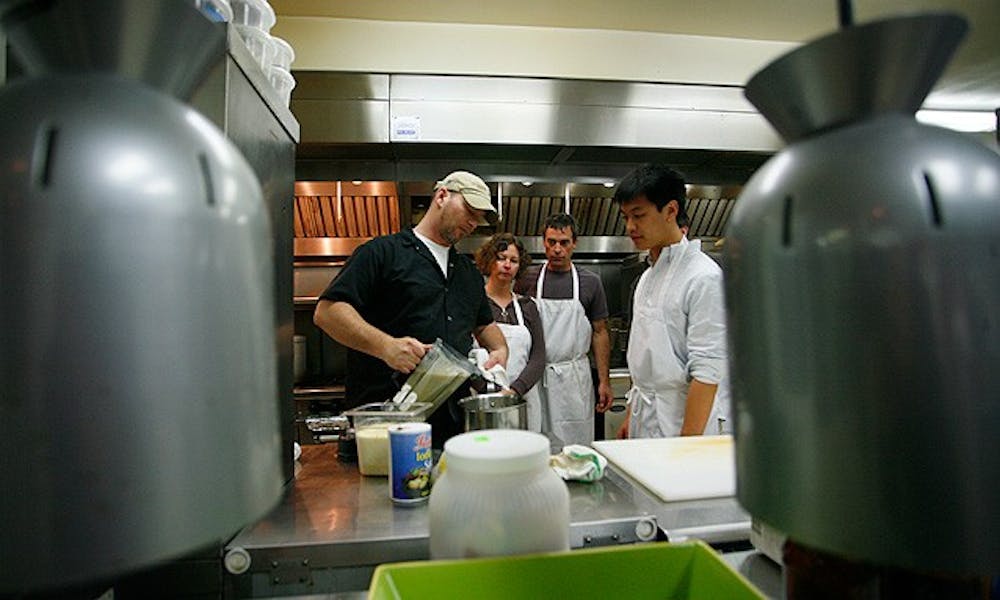Jim Anile, executive chef at Revolution, was the first person to welcome me that morning. Sitting on a chair normally reserved for hungry, hopefully patient dinner guests, he sized me up immediately. “There’s coffee over there if you want some,” he said, extending his hand toward the end of the bar. I wanted some.
Cradling my coffee, I casually chatted with Anile about his new restaurant, set to open in May at American Tobacco. Then, four of my friends walked in, breathing reminders that I wasn’t the only one in this class. Back in July 2010, we each bought a LivingSocial deal good for one cooking class at the downtown Durham food phenom. The knives and stovetops were abstractions when we all forked over our $100—half off!
The restaurant does not use recipes. This is central to Anile’s philosophy: It was the first thing he said to us, his pupils for the day, and it was a refrain during the four-and-a-half-hour course. At one point, he instructed me to “just pour some flour in there,” a startlingly simple directive for someone who’s constructing homemade pasta.
The cooking courses, which Revolution calls “Chop Shop,” are offered only on certain Sundays. Each has a theme, and ours was “Handmade Regional Pastas and Sauces.” We were first treated to a primer on the different types of pasta—including egg- and potato-based—before we were dispatched in teams to work on different projects.
The several teams, directed by Anile and supplied and cheered on by Quentin Dyson, the restaurant’s dinnertime expediter, made slow progress on the dishes we would prepare: gnocchi, ravioli and flat egg pasta. One team sliced red peppers and separated the hearts of Brussels sprouts from their leaves. Another forced vegetables through the meat grinder and then mixed them with ground beef; this was to be the filling for our homemade ravioli.
A subset of my egg-yolking team—all of us were separated and reunited several times over the course of the day—was instructed to create a sauce for the gnocchi from cauliflower, shallots, potatoes, spinach and vegetable stock. The giant, smoldering, garlicky white head of cauliflower had been crisped with some olive oil and was chopped into smaller chunks. The shallots were easy—they had been pre-peeled and stored in a white container for us. We peeled the potato, which was employed to thicken the sauce so we didn’t have to use cream, and plopped it into the pot. The spinach and vegetable stock would not enter that pot so effortlessly.
It sunk in clearly and quickly, after a minced finger and nearly spilt stock, that a lot more work—much of it mundane, thankless and potentially dangerous—goes into preparing food than we might be comfortable with.
For me, this realization adds essential nuance to nasty Yelp reviews and helps explain why, at 11:30 a.m., Anile emerged from somewhere with two types of homebrewed beer. For the remainder of the cooking class, we had beer with us, or close by. When the glassware ran out, we used wide, shallow, plastic containers as stand-ins, which is what the kitchen staff use to drink their beer during a rough night.
And rough nights abound—kitchens are damn stressful. You have to truly love the culinary arts to stick with it as long as Anile has.
“I have mellowed out with age,” said Anile, perhaps because he’s seen all the ways a kitchen can stumble.
Indeed, when our group ruined the pasta for the last course, Anile reacted as he had to each setback that day: He shrugged it off and came up with a new plan for the final dish.
“Quentin, grab me those white beans—the Cannellini beans—from downstairs, please,” he hollered. “Can someone grab me the olive oil and get some white wine for this sauce?” Dyson, in his duties as expediter, must coordinate the different stations in the kitchen, which only see orders for their own area.
Each part of the class—from preparing to cooking to consuming—was full of wonder and representative of something that deserves incredible respect. Much of the food at Revolution reminds me of a device like the Apple iPad, and not just because the dining room resembles a Bohemian Apple Store.
We often describe what we buy—the meal or the gadget—as magical, as if it comes from a place too beautiful and perfect to imagine. And then we learn what that place—a kitchen or a factory—is actually like, and realize it’s a miracle itself that something so complex could ever create such a gem.
Get The Chronicle straight to your inbox
Signup for our weekly newsletter. Cancel at any time.

